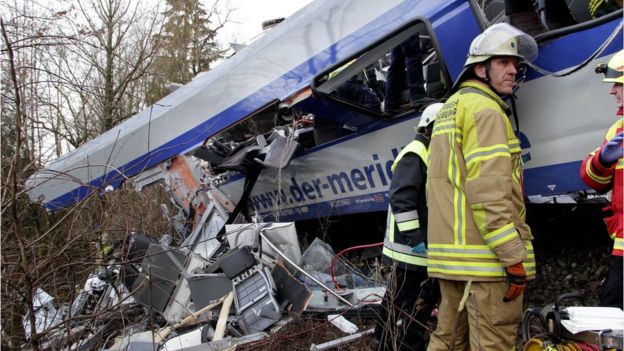Germany train crash: Several killed near Bavarian town of Bad Aibling

At least 10 people were killed and scores more injured, police say, after two passenger trains collided in the German state of Bavaria.
The head-on crash happened near Bad Aibling, a spa town about 60km (37 miles) south-east of Munich.
The transport minister said the trains had crashed into each other while both travelling at around 100km/h (62mph).
Emergency teams, some winched in by helicopter, worked for hours to free casualties from the wreckage.
What we know
The accident occurred on a single-track route between Rosenheim and Holzkirchen at about 07:00 local time (06:00 GMT)
Officials say they assume both train drivers had no visual contact before the crash as the site is on a bend — and therefore crashed into each other largely without braking


The stretch of line had an automatic braking system designed to halt any train that passed a stop signal. It is not yet known why this failed to stop the crash
Two of the three data recorders or "black boxes" on board the trains have been recovered
Chancellor Angela Merkel said she was "dismayed and saddened" by the crash.
Regional police said that 10 people had been killed and revised down the toll of injured to 80, 17 of them seriously.
One person is still missing, they say.
The drivers of both trains and two train guards were among those killed, police said.
Analysis by Richard Westcott, Transport correspondent
It seems likely that one of the trains ran a red light, but it's hard to know why. It could be human error, technical problems or a combination of the two.
The line is fitted with a modern safety system that slows the train down if it is going too fast and then stops it automatically if it passes a red signal.
Drivers get warnings in the cab if there is a problem. The speed of each train suggests neither had any warning.
And it is highly likely they'd have known the route, too.
Only by analysing the data recorders or "black boxes" will investigators know for sure what happened.
It's incredible that so few people lost their lives and that's almost certainly because of the huge improvements in train design over the years. They are much safer than they used to be.
German Transport Minister Alexander Dobrindt, who visited the scene, said it was a "horrifying sight".
"The drivers' cabs of both trains are wedged into each other. One side of one train is completely torn open. The other train bored into it," he told a news conference.
Bavarian Interior Minister Joachim Herrmann told the same conference it was "difficult to comprehend" how such a crash could happen given the amount of investment in railway safety following previous train accidents.
Electrical engineer Joe Adediran, who was on the train between Rosenheim and Holzkirchen, said that he had had a "lucky escape".
"At the first station, this train normally has to wait for five minutes or so for the opposite one to arrive. After a while, we started to move on to the next station without waiting for the opposite train," he told.
Grey line
Other fatal German train crashes
January 2011: 10 killed in Saxony-Anhalt when commuter train collides with goods train after driver runs through two signals
February 2000: Nine dead when overnight train from Amsterdam to Basel crashes near Cologne
June 1998: 101 killed when a high-speed train with a broken wheel derails and smashes into a bridge at Eschede in Lower Saxony
Grey line
The scene of the crash is close to the Mangfall river in a hilly and densely wooded region.
The Munich blood bank issued an appeal for blood donors on its Facebook page (in German).
Политика конфиденциальности | Правила пользования сайтом











